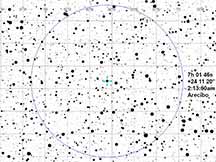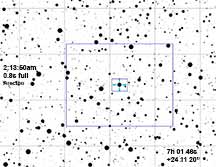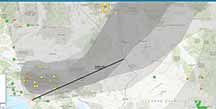The Occultation of a 10.4 Star by the Binary Asteroid Arecibo
Sat morn Sept 14, 2024 at 2:13:51am at Parker Junction, CA
OWc page
This event is on the short list of high value IOTA Campaign events, and so should attract a good number of observers. Recall the binary nature of this asteroid was discovered by Dave Gault and Peter Nosworthy in Australia, and then another favorable occultation in central California was gotten by myself and Kirk Bender, confirming the binary nature and getting better data on the size of the other component. A new paper in the journal "Astronomy and Astrophysics" ("Asteroid (4337) Arecibo. Two Ice-Rich Bodies Forming a Binary" - Liu et al. 2024) has just appeared, and used our data and GAIA astrometry data to attempt to determine precise values of the orbit and hence the sizes, shapes, masses, densities of this rare binary asteroid. However, we have only 2 good occultations which show the 2 components, and the semi-major axis is still known only approximately. We need more occultations to constrain the solution space for the orbital parameters.
This is a very favorable occultation; W=10.4 magnitude is bright, and the duration of 0.8 seconds is long enough to permit high cadence and hence accurate D and R times and hence object sizes. A good campaign result should finally solve the sizes of the objects to high precision, and much better constrain the semi-major axis. The altitude is low, but higher farther east in the U.S. Still, it is 16 degrees altitude at Parker Jct in the California Mojave Desert, and this is high enough to permit good data for such a bright star. We should be able to record at 2x, and perhaps even at 1x. We'll want to use any early morning event that we otherwise get before Sept 14 to record the target star and see what cadence will be possible under clear skies. There will be an 81% waxing moon but it will have set by the time of the occultation, so skies should be very black at our site. All this is IF there is no smoke from the SoCal wildfires.
I would advocate that we plan to leave Santa Cruz at ~noon Friday Sept 13, and there looks to be good prospects for one or maybe two asteroid occultations we can get on the drive to Cleghorn Lakes Wilderness for Arecibo. I'm looking into such additional asteroid events now.
Here is a small scale US map of the path
The moon is 78% and 89% on Fri night and Sat night, It's a weekend, and high value, and so I hope that Kirk and I and perhaps another person can try this one. I will look for other event(s) before and after the primary in order to maximize the science.
GaiaMoons site, with path for satellite and main body.
Alt=16, Az=67
On Date Coords of target star
RA 7h 01 45.7s
Dec= +24 11 20"
My Observing site Coordinates:
Lat: 34 45 54.69
Long: 114 35 25.25
Elev: 722 ft

Our assigned lines. I'm putting Kirk at 7 not me, because he has finer time resolution for the satellite. I'm assigned 4.5. Track 0 is centerline and track 5=northern limit of OW prediction. Satellite is going to be slightly overlapping the main body, Kirk and I may both get double occultations. Satellite is north of the main body. |

The target is in the geometric center of the asterism of Gemini; right between the twins at their waist. |
 |

Kirk's site at the south outskirts of Needles, in the large vacant lot at the bend in Hwy 95. |

My observing site, on "5 mile road" just a half mile south of Parker Jct. |
Smoke map current conditions. Hit refresh to get the latest. Fire smoke image maps are below...
RapidRefresh Smoke maps. Click on the latest link to "vertically integrated smoke" to get map for their current most foreward forecast. You'll have to wait till just before leaving to get a forecast for event time.
NearSurface smoke
PurpleAir surface air quality 2.5pm concentrations.
A NOAA web site air quality forecast map is here:
https://airquality.weather.gov/?element=smokes01&mapcenter=-110.50%2C37.00&mapzoom=6&subregion=SW®ion=CONUS

This is the latest predicted map, which is still 17hr before the event and shows smoke still over the planned site. But the prediction is for winds to be shifting out of the south more and blowing the smoke more directly north and leaving Parker Junction ~clear. |

Another current condition map Smoke map current conditions. not valid for event time. |

This is Yanzhe's mobile app for smoke as prediction (for event time) which shows a more positive picture of not much smoke at event time, at Parker Jct. |

Proposed campsite, north of Needles. |
|
Results
Richard Nolthenius
I observed from the track 4.5 where it intersected Five Mile Rd, at a pullout on the east side of the road and not far from an abandoned mobile home. I saw no evidence of any smoke, lit by the 84% moon, nor any wind. Temperature around 80F at 2am. The seeing looked quite good, surprisingly. I could see the target easily at 1x (1/50s) and did use this setting. I analyzed in "field mode" in PyMovie. I used the standard 4px radius circular static aperture, which left some blank sky around the target. I believe sky-subraction was not good given the clipped non-Gaussian distribution of sky counts, which of course cannot go below 0 value. PyMovie assumes the sky is always bright enough that the sky counts will be Gaussian distributed about some significantly positive enough value so as to not be clipped. This can be done directly in the Watec camera if the IRE is set to 7.5, as is possible in the NTSC version of the camera. But the PAL version of the camera has the IRE=0 hard-wired in and cannot be changed, and hence there is a sky subtraction problem unless your background sky is brightened sufficiently by moonlight or city lights or long integrations.
After apparently choosing the wrong target star in my rush to get results done after my usual ~5 hr or less of nightly sleep, and by emails reporting a miss. Dave Herald did a careful analysis of all past Arecibo and relevant Gaia data and found that I should have had a short event of the moonlet, and suggested a re-analysis was in order. I did so, and turns out he was right. I got a very clear and obvious high-confidence 0.49s event at a time that agrees with it being caused by the moonlet. Humbling! It appears what happened is not that I failed to ID the target star, but rather that the late night analysis was done on a reference star, not the target, and the real prospect of a miss on both moon and main body means I wasn't that surprised to see a miss, and did not adequately confirm what I'd done.
Note that for this 1x field mode recording in dark skies, the sky counts are severely clipped and the true 'zero' level is quite above zero. The PyOTE light curves shows clearly that the light drop was essentially 100%, not 92.8 as PyOTE determined, above an erroneously low "zero" point.
magDrop report: percentDrop: 92.8 magDrop: 2.850 +/- 0.550 (0.95 ci)
DNR: 3.17
D time: [09:13:51.7071]
D: 0.6800 containment intervals: {+/- 0.0082} seconds
D: 0.9500 containment intervals: {+/- 0.0205} seconds
D: 0.9973 containment intervals: {+/- 0.0430} seconds
R time: [09:13:52.1937]
R: 0.6800 containment intervals: {+/- 0.0082} seconds
R: 0.9500 containment intervals: {+/- 0.0205} seconds
R: 0.9973 containment intervals: {+/- 0.0430} seconds
Duration (R - D): 0.4866 seconds
Duration: 0.6800 containment intervals: {+/- 0.0116} seconds
Duration: 0.9500 containment intervals: {+/- 0.0262} seconds
Duration: 0.9973 containment intervals: {+/- 0.0520} seconds

PyMovie composite light curves |

Target light curve, with the nominal predicted event time at 9:13:51.00 marked. Clear half-second event at the right time. |

Zoomed in, with label for central event time from Kirk's data (no correction for along-track time difference). |

This event - with an extremely short integration 1/50s- would be expected to have a very dark sky count and hence for IRE=0 in the Watec 910hx, a very clipped histogram for the sky counts. Here, I artificially dragged the bottom of the displayed histogram to unphysical negative values just to highlight the clipped distribution. PyMovie assumes the sky counts are Gaussian distributed and clearly in the case of a clipped distribution at the faint end, this is not true. How does this affect my PyMovie photometry? See below... |

The anticipated shadow projections for the main body and moonlet. You can see that at my location and Kirk's there was good liklihood of a double occultation. Kirk and I both had a single occultation of the moonlet, and I had no occultations. The cross-track spacing of the two objects looks to be larger than expected. Also perhaps a south-shift. |

Minimized metric both by smoothing and offsetting to account for any slight remnants of drifting wildfire smoke. |

Event lines up fairly well with Kirk's a few miles north of me. |

Sharp D and R's, and good confidence intervals. No evidence of an occultation by the primary. Note the "sky" counts are at the same level as the star counts, it's essentially a 100% occultation. |

False positive test passes. |
|
I note that my light curves have a detectabley bit more point-to-point noise than Kirk's. This, even though my integrated light is 20% larger per point, hence should be a bit better S/N. I speculate that it is because the sky light subraction is poor, given the very clipped histogram of sky counts for my PAL camera and very short 1/50s time integration.
revised IOTA report sent in 10/16/24, and to Dave Gault. LuckyStar report sent in Dec 14, 2024.
Kirk Bender
A 0.3435 clear positive for Arecibo, 1x (1/60 sec) integration from Needles, CA.
About 2 seconds late from the main body prediction.
I submitted a report, here's additional files for your information. Although it doesn't mention Lucky Star on Occult Watcher Cloud, the event is on the Lucky Star occultation portal calendar, I suppose we should fill out their forms and submit our movie files, although I didn't do a dark frame at the time.
magDrop report: percentDrop: 96.2 magDrop: 3.558 +/- 2.185 (0.95 ci)
DNR: 2.50
D time: [09:13:51.9679]
D: 0.6800 containment intervals: {+/- 0.0057} seconds
D: 0.9500 containment intervals: {+/- 0.0173} seconds
D: 0.9973 containment intervals: {+/- 0.0578} seconds
R time: [09:13:52.3114]
R: 0.6800 containment intervals: {+/- 0.0057} seconds
R: 0.9500 containment intervals: {+/- 0.0173} seconds
R: 0.9973 containment intervals: {+/- 0.0578} seconds
Duration (R - D): 0.3435 seconds
Duration: 0.6800 containment intervals: {+/- 0.0086} seconds
Duration: 0.9500 containment intervals: {+/- 0.0234} seconds
Duration: 0.9973 containment intervals: {+/- 0.0656} seconds
Other Images




























